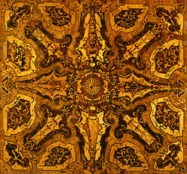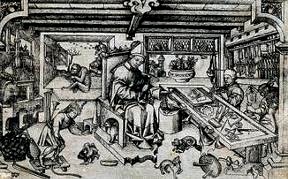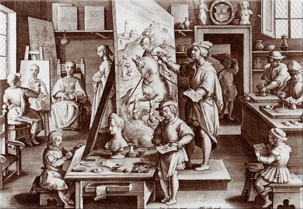This site is made possible by its sponsors.
Please visit them!
maquette - A small sculpture made as a preparatory study or model for a full-scale work.
(pr. mə-KET)
Examples:

Le Corbusier (born Charles-Edouard Jeanneret)
(French, born Switzerland, 1887-1965), Unité d'habitation, Berlin-Tiergaten,
1957-1958, maquette d'étude (study model) of wood
(solid and sheet), 55 x 122 x 90 cm, Georges Pompidou Center,
Paris. See pseudonym.

Gustav Klutsis (Latvian, 1895 - c. 1944), Maquette for Radio-Announcer, 1922, construction of painted cardboard,
paper, wood,
thread, and metal brads (nails),
45 3/4 x 14 1/2 x 14 1/2 inches (106.1 x 36.8 x 36.8 cm), Museum
of Modern Art, NY. See Constructivism
and Russian art.
margin - An edge and the area immediately beside it, as of a page. A border.
Also see marginalia and remarque.
marginalia - Notes in the margin or margins of a page in a book, sketchbook, or sheets of paper. Drawing in the margins or borders of prints is called remarque.
Also see palimpsest.
marionette - In puppetry, a small-scale, complete figure, usually of a person or animal and made of wood, that is moved from above by strings or wires that are attached to its jointed arms, legs, and body.
Resource concerning marionettes:
Also see theater.
mark - A visible trace or impression on a surface, such as a line, a dot, spot, stain, scratch, blemish, mar, bruise, crack, dent, boss, kerf, or pleat.
Also see abrade, align and alignment, carve, change, distress, draw, etch, paint, palimpsest, patina / patinate, register, rugosity, signature, and transform.
market value or market worth - The monetary equivalent of an art object, writing, intellectual property, etc. (Market value should not to be confused with the term value.) This can be needed in order to better know what price to ask or pay for it, to appropriately insure it, or out of simple curiosity. Market value can be determined with varying degrees of reliability either through an appraisal, by offering it for sale either via auction or gallery (traditional or online), or by an advertisement placed in a newspaper or magazine. [A much more in-depth article on this subject is coming soon.]
About market value or market worth:
Internet resource concerned with market value:
Also see Artist PensionTrust (APT), bad-debt art, commission, commodity, and posthumous.
marouflage - A painting done on canvas and then cemented to a wall or panel.
(pr. MAY-rə-FLAZH)
Also see bricolage, collage, découpage, femmage, frottage, fumage, montage, parsemage, photomontage, and mural.
marquetry - Inlay or veneers of wood form a pictorial image; as related to parquetry which forms geometric designs. At the height of its use in late 17th century France, fine furniture was embellished with marquetry produced with such rare and extremely expensive materials including ebony, tortoiseshell, and brass, often inspired by Japanese lacquer. In the 18th century marquetry began to be created in exotic woods — Brazilian rosewood, violet wood, mahogany, sandalwood, etc. — in colors including reds, yellows and greens. Marquetry furniture reflected the taste for all things floral, and paralleled the 17th-century "tulipmania" and the work of Dutch painters such as Van Huysum. Frisage is a marquetry technique in which small flakes of precious woods are cut diagonally and arranged so the direction of the grain of the wood produces optical effects akin to iridescence. "Diamond" and "butterfly wing" designs of c. 1720 were achieved in this way.
(pr. MAHR-kə-tree)
Examples:


English, Escritoire, c. 1690, marquetry and walnut
veneer, 169 x 114 x 49 cm,
Whitney Antiques, Whitney, England. These pictures show this
desk as it looks when it's closed, and when it's
open.

![]()

German, Floor, c. 1715-1720, pine, marquetry
with kingwood, bois satiné, sycamore, tulipwood, and olive,
9 feet 11 inches x 10 feet 11 inches, Getty Museum, Malibu, CA.
Detail:
c. 3 x 3 feet.
mars pigments - Artificial iron oxide pigments, yielding strong tints from yellow through brown to violet.
Masonite ® - A trademark used for a type of fiberboard employed as a surface for painting, but manufactured principally as wallboard for use in insulation, paneling, etc. It is dark brown, with one side that is very smooth, and the other bearing the texture of an impressed wire screen. Gesso is commonly applied to Masonite as a ground. Masonite can be quite permanent. It often occurs in print in lowercase, to the dismay of the owner of the rights to this trademark.
Example of work on Masonite:

Albert Bloch (American, 1882-1961), March of the Clowns, 1941, oil on canvas mounted on Masonite, sight: 35 9/16 x 39 7/16 inches (90.3 x 100.2 cm), framed: 41 x 45 inches (104.1 x 114.3 cm), The Jewish Museum, NY. Bloch was a member of the artists' group called Der Blaue Reiter. See Jewish art.
|
|
masonry - A construction made of brick, stone, or concrete, joined by mortar. Might also refer to incrustation — the earliest style of Roman fresco painting.
Also see ablaq, architecture, nails, and the names of various architectural elements, such as arch, vault, etc.
mass - Refers to the effect and degree of bulk, density, and weight of matter in space; the area occupied by a form such as a building or sculpture. As opposed to plane and area, mass is three-dimensional.
Works that makes the viewer aware of its mass, and and the massing of its parts:

Mesopotamia, Weight in the Shape of a Sleeping Duck, c. 2000 - 1500 BCE, carved limestone, length 35.2 cm — an unusually large size, private collection, Europe. The massive and highly stylized bird is shown with a plump body and flaring tail, and easily transcends its original and somewhat prosaic function. The head, on an elongated neck, is turned to rest on the back. The simplified contours combine with the tactile surface invite comparison to sculptures by Constantin Brancusi and other modern sculptors. See Mesopotamian art and weight.
Henri Matisse (French, 1869-1954), Henriette III (Large Head), 1929, bronze, height 40 cm, Hermitage Museum, St. Petersburg, Russia.
Also see volume.
mass media - Means of communication to a large population — a mass of people. These generally include newspapers, magazines, radio, or television.
Also see ephemera, new media, and popular culture.
mastaba - A low rectangular ancient Egyptian tomb made of mud brick or stone masonry, with sloping sides and a flat top. It covered a burial chamber.
(pr. mə-STAH-bə)
Example:

Egypt, Lower Egypt, Saqqara, Tomb of Perneb, c. 2350-2323 BCE,
end of Dynasty 5, Old Kingdom, partially painted limestone,
height 16 feet 7/8 inches (482.2
cm), Metropolitan Museum of Art, NY. This tomb included an underground
burial chamber and a mastaba containing a decorated offering
chapel and a statue chamber, usually called a serdab.
Also see adobe, Egyptian art, and pyramid.
master, old master, and master's degree - In the arts, a master is a person whose teachings or doctrines are accepted by followers. In the old apprenticeship system, a master was an artist of great and exemplary skill, whose followers might be called apprentices or disciples.
The "old masters" are artists recognized in the canon, most often from the fifteenth through the seventeenth centuries.
The college degree most often achieved after that of a "baccalaureate (bachelor's) degree" is a "master's degree." The one most often following this is a doctorate (Ph.D.) In the visual arts, the master's degree a student most often achieves is a Master of Arts (M.A.) degree or a Master of Fine Arts (M.F.A.) degree. With few exceptions, a master's degree is the "terminal" degree, meaning there is no doctorate available in most visual arts disciplines. One notable exception is in art history.
The Latin "magister" is an ancestor of "master." "Maitre" is the French word for "master," and "meister" is the German one.
Examples:

Master of Balaam, Dutch, St. Eligius in His Studio, c. 1450, engraving on paper, 11.5 x 18.5 cm, Rijksmuseum, Netherlands. A man in a bishop's mantle is working in a metalsmiths workshop. "The man is Eligius, patron saint of smiths. He is hammering a goblet into shape on his anvil. Three other people are working in the studio: a master smith and two apprentices. The table is covered with tools. On the right, hammers, tongs and files hang in orderly rows against the wall. On the left is the furnace."

Jan van der Straet (Stradanus) (Dutch, 1523-1604),
Painter's
Studio, woodcut.
As the master paints a large canvas with a picture
of St. George and the Dragon at the center, an apprentice
paints a portrait from a model at left, two make drawings and one mixes colors in the foreground,
two more grind pigments into
oil on the right, and a last
one carries a canvas toward the doorway. Windows let in natural
light from several angles. There are numerous shelves, drawers
and tables for supplies and works-in-progress. See studio.
Quote:
Also see architect, artisan, DWM, masterpiece, teacher, and virtuoso.
masterpiece or masterwork - A work done with extraordinary skill; especially a work of art, craft or intellect which is an exceptionally great achievement. To some, this means the best piece of work by a particular artist or craftsperson. Historically, a piece of work presented to a medieval guild as evidence of an apprentice's qualification to attain the rank of master. Also called masterwork. First known in English in the early 17th century, this word was derived from the Dutch meesterstuk or from the German Meisterstück. The French equivalent is chef-d'oeuvre. Synonymns might include: classic, jewel, magnum opus (Latin for "great work"), ne plus ultra (Latin for "nothing is higher"), nonpareil (French for "without equal"), tour de force (French for "feat of strength"), pièce de résistance (French for "piece with staying power"), summit, prize, treasure, masterstroke, and crowning achievement.
Quote:
Also see apprenticeship, artwork, assessment, crown, piece, composition, fame, genius, love, object, objet d'art, posterity, quality, standards, success, talent, and virtuosity.
mastic - A gum or resin obtained from certain coniferous trees, used in varnish, employed as a medium, as an adhesive, or as a sealing agent.
mat, matt, or matte - A decorative border placed around a picture, often under glass, also called matboard. It serves as a frame or provides contrast between the picture and the frame. Or, to put a mat around a picture. Also, a thin, flat sheet of glass fiber material used to reinforce laminating resin, hollow cast ciment fondu, and modeled concrete sculpture. Surface mat is quite fine, chopped strand mat is coarse, loosely woven fabric. Also, having a dull, flat, non-reflective, sometimes roughly textured finish, perhaps of paint, metal, paper or glass; the opposite of glossy.
Example:

Unidentified photographer (American?), Woman looking at framed tintype portraits, c. 1870, tintype with decorative paper mat, 12.4 x 7.7 cm, George Eastman House, Rochester, NY.
Also see edge, matting tools, mount, polyurethane, preparator, semi-matt, semi-gloss, and water gilding.
matboard - A mat that is typically cut from a heavy cardboard. Matboard serves two very important functions in the overall framing of a picture. First and foremost it protects the artwork and second it showcases and enhances the subject being framed. It is important to protect works of art on paper, photographs, and other framed objects from direct contact with glass. Matboard provides a barrier from the airborne pollutants, moisture, acids and other damaging impurities that can impact the life of the framed piece. Matboard when used correctly also leads your eye into the artwork, enhancing the overall effect. Whenever a work's presentation or storage environment should be of archival quality, be sure to use acid-free matboard. It is more expensive, but is much less likely to discolor artworks over time.
matching - Making a harmonious pairing or grouping of materials or objects, usually based on formal qualities.
Also see complementary colors.
material - The substance(s) or object(s) out of which something is or can be made. Examples include: clays, fibers, glass, papers, plastics, metals, pigments, stones, woods, etc. In body art the material might be the artist's body. In conceptual art there might be no material at all.
Speakers frequently confuse material with medium (plural: media). Some materials are or can be both materials and media. Examples of materials that might be said to be media: bronze, canvas, charcoal, fiberglass, glass, lead, paint, plaster, sand, and stucco.
Materials can vary from each other in many ways, some based upon formal qualities, chemical and/or biological composition, behavior in various conditions, market value, connotative or denotative meanings. Consider these aspects of materials:
Quotes:
Also see adobe, Art & Creative Materials Institute (ACMI), ASTM International (American Society for Testing and Materials), cement, corrugated cardboard, feather, medium, memory, mortar and pestle, packaging, placeholder, polymer clay, support, and Styrofoam.
material culture - All of the physical products of a culture: painting, sculpture, architecture, decorative arts, books, tools, arms and armor, costumes, musical instruments, advertisements, etc. Similarly inclusive is the term visual culture.
Also see applied arts, art, commercial art, craft, ethnosphere, popular culture, and realia.
Material Safety Data Sheet (MSDS) - A Material Safety Data Sheet (MSDS) contains basic information intended to help you work safely with a hazardous material. Some such information is likely to be posted as a label on the product. It might also be posted on the manufacturer's Web site. An international organization whose members are hundreds of manufacturers of art materials, the Art & Creative Materials Institute (ACMI), authorizes the placement of its seals — AP and CL — on packaging, in order to inform consumers of the safety and hazards of those products. In the United States the Occupational Safety and Health Administration (OSHA) is the federal agency that specifies what information must be given on the label and MSDS for every material that OSHA has classified as hazardous.
Other resources concerning material safety:
Also see adhesives, ASTM International (American Society for Testing and Materials), caustic, ergonomics, flammable, fumigation, hazardous, package, pigment, poison, preparator, solvent, toluene, toxic, volatile, and xylene.
materialism - The point of view that physical well-being and worldly possessions matter most in life. Alternatively, an excessive regard for worldly concerns.
matt or matte - See mat.
matting tools - Punches with patterned striking faces (often criss-crossed or granulated) used in chasing to texture metal surfaces after casting.
Also see mat.
mature - To bring to or to be in a state of stable solidity or hardness. Said of plasters, clays, glazes, some plastics, and other substances. Sometimes the change occuring is a chemical one, as with gypsum plaster. With ceramic or glazed work, high enough temperatures must be reached that these materials vitrify.
(pr. mə-CHəR or mə-TYəR)
Also see maturing point.
maturing point - The temperature at which all gases are driven out of clay. And the temperature at which powdered glaze or enamel fuses. Also see mature.
maul - A wooden club used to strike a wood carving chisel. A maul is shaped from a single piece of wood taken from the base of a young tree.
maulstick - See mahlstick.
mauve - Pale bluish to deep purple in color. It was the first of the aniline dyes developed by the English chemist William Henry Perkin in 1856, while he was trying to synthesize the drug quinine from coal tar. The word "mauve" is derived from what the French named it: mauveine. In its first decades, mauve was a huge commercial success.
mbari - Ceremonial houses filled with clay sculptures and paintings, honoring community deities of the Ibo tribe in Africa.
Also see African art.
https://inform.quest/_art